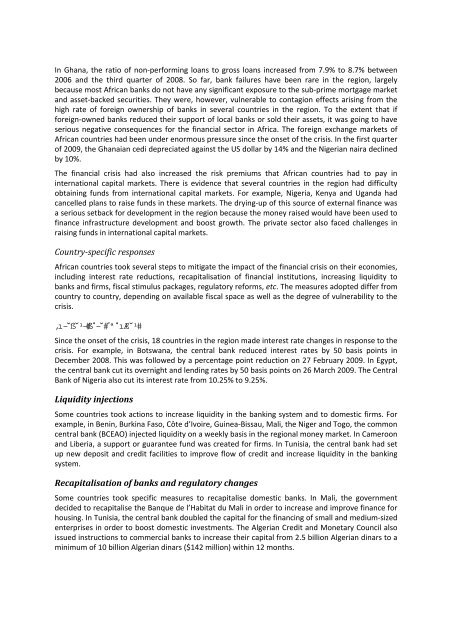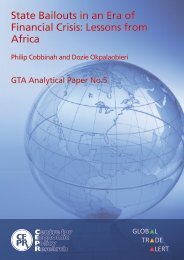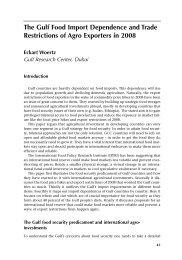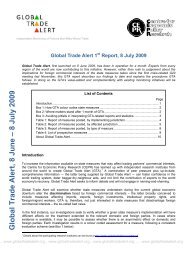In Finland, the banking market is heavily concentrated and the banks have not faced seriousdifficulties. There are a number of alternative explanations for the banks’ relatively goodperformance during the crisis. First, the crisis in the early 1990s with large‐scale bank failuresprovided a lesson that may still have affected the propensity to be excessively exposed to risks.Secondly, although Finnish banks expected that lending will decrease in 2009, this decrease has tobe viewed against the fact that from the outbreak of the global financial crisis, Finnish banks actedincreasingly as substitutes to drained foreign lending channels, thus increasing their lending. Thirdly,it is possible that the financial crisis had not yet had its full effect and that the effect for Finland islagging. On 12 December 2008, the parliament authorised the government to grant state guaranteesfor the refunding of Finnish banks to a maximum value of €50 billion. However, the surveys of theConfederation of Finnish Industry (CFI) in early 2009 indicated that access to credit has notconstituted bottlenecks in production. The concentration of the Finnish banking markets wasaffected by the exit of two Icelandic banks in 2008. These banks grew quite swiftly, partly due tofierce competition in deposit interest rates. Lack of investor confidence and liquidity problemscontributed to their exit.In Italy the financial system has proved quite resilient to the effects of the financial crisis. However,the issues of corporate governance highlighted in the Competition Authority’s inquiry need to beaddressed in order to improve the performance and the stability of the system. Specifically, strongermarket disclosure, combined with a more transparent governance that increases autonomy andindependence of administrators, can contribute significantly to strengthen furthermore the system’sreputation and its level of competition.In Iceland, where the economy was very dependent on the finance sector, economic problems havehit them hard. The banking system virtually collapsed and the government had to borrow from theIMF and other neighbours to try and rescue the economy. However, Iceland has raised its interestrates to some 18%, partly on advice from the IMF. It would appear to be an example where highinterest rates may be inappropriate. The economic problems have led to political challengesincluding protests and clashes. But as Krugman notes, capital controls may have also helped Icelandas well as having its own currency and making the banks pay for the problems rather than makingthe public pay, which is what has since happened in Ireland which now faces a massive bailout andvery severe austerity measures. It may be that this time round a more fundamental set of measuresneeds to be considered, possibly global in scope. The very core of the global financial system issomething many are now turning their attention to.Africa and the Financial CrisisWhile it is true that the advanced economies were the hardest hit by the crisis, with growth rateprojections declining from 2.7% in 2007 to about 1.0% in 2008, developing economies were notspared. As the global financial crisis continued to deepen, world output growth prospects,particularly for 2009 and 2010, had been downgraded at least a few times. Growth in developingeconomies, including emerging economies, was estimated at 6.3% for 2008, down from the realisedgrowth rate of 8.3% in 2007. Africa was initially believed by many pundits to be somehow insulatedfrom the global financial crisis, because of the relatively limited level of integration of most Africanfinancial markets with global financial markets. However, the continent witnessed some adverseeffects, evidenced in a slowdown in the rate of growth from 6.2% in 2007 to 5% in 2008.The impact of the crisis on Africa came from both direct and indirect channels. The direct effects hadbeen felt mostly through the financial sector. For example, stock market volatility had increasedsince the onset of the crisis and wealth losses had been observed in the major stock exchanges. InEgypt and Nigeria, the stock market indices declined by about 67% between March 2008 and March2009. The turmoil in African stock markets had had significant negative effects on the financialsector, and on aggregate demand. For example, there was growing evidence that it had a negativeeffect on bank balance sheets and a continued trend was likely to increase non‐performing loans inthe banking sector, with dire consequences for financial stability in the region.
In Ghana, the ratio of non‐performing loans to gross loans increased from 7.9% to 8.7% between2006 and the third quarter of 2008. So far, bank failures have been rare in the region, largelybecause most African banks do not have any significant exposure to the sub‐prime mortgage marketand asset‐backed securities. They were, however, vulnerable to contagion effects arising from thehigh rate of foreign ownership of banks in several countries in the region. To the extent that ifforeign‐owned banks reduced their support of local banks or sold their assets, it was going to haveserious negative consequences for the financial sector in Africa. The foreign exchange markets ofAfrican countries had been under enormous pressure since the onset of the crisis. In the first quarterof 2009, the Ghanaian cedi depreciated against the US dollar by 14% and the Nigerian naira declinedby 10%.The financial crisis had also increased the risk premiums that African countries had to pay ininternational capital markets. There is evidence that several countries in the region had difficultyobtaining funds from international capital markets. For example, Nigeria, Kenya and Uganda hadcancelled plans to raise funds in these markets. The drying‐up of this source of external finance wasa serious setback for development in the region because the money raised would have been used tofinance infrastructure development and boost growth. The private sector also faced challenges inraising funds in international capital markets.Country‐specific responsesAfrican countries took several steps to mitigate the impact of the financial crisis on their economies,including interest rate reductions, recapitalisation of financial institutions, increasing liquidity tobanks and firms, fiscal stimulus packages, regulatory reforms, etc. The measures adopted differ fromcountry to country, depending on available fiscal space as well as the degree of vulnerability to thecrisis.Since the onset of the crisis, 18 countries in the region made interest rate changes in response to thecrisis. For example, in Botswana, the central bank reduced interest rates by 50 basis points inDecember 2008. This was followed by a percentage point reduction on 27 February 2009. In Egypt,the central bank cut its overnight and lending rates by 50 basis points on 26 March 2009. The CentralBank of Nigeria also cut its interest rate from 10.25% to 9.25%.Liquidity injectionsSome countries took actions to increase liquidity in the banking system and to domestic firms. Forexample, in Benin, Burkina Faso, Côte d’Ivoire, Guinea‐Bissau, Mali, the Niger and Togo, the commoncentral bank (BCEAO) injected liquidity on a weekly basis in the regional money market. In Cameroonand Liberia, a support or guarantee fund was created for firms. In Tunisia, the central bank had setup new deposit and credit facilities to improve flow of credit and increase liquidity in the bankingsystem.Recapitalisation of banks and regulatory changesSome countries took specific measures to recapitalise domestic banks. In Mali, the governmentdecided to recapitalise the Banque de l’Habitat du Mali in order to increase and improve finance forhousing. In Tunisia, the central bank doubled the capital for the financing of small and medium‐sizedenterprises in order to boost domestic investments. The Algerian Credit and Monetary Council alsoissued instructions to commercial banks to increase their capital from 2.5 billion Algerian dinars to aminimum of 10 billion Algerian dinars ($142 million) within 12 months.









